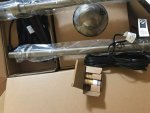The weak links in outdoor lighting are the bulbs and the connections. VOLT hardware is all solid brass (if that's the model you're getting), they'll last forever. There's a member here who wrote the LED bulbs don't last all that long, because of the tiny circuits they have on board, but mine are going strong after three years now, so my experience has been great. So that leaves the connections. VOLT supplies some good connectors, that are designed for outdoor use, but having messed with lesser systems for years, I wanted this latest system to be my last. So I took the extra step of soldering all my connections. I then used the VOLT water-resistant connectors in addition to that. I realize soldering is beyond the skills of some, but if you can manage it, I believe it to be worth the effort. The resulting electrical connection will not be subject to physical stress or corrosion, and will never fail, or worse, partially fail causing flickering or reduced brightness.
The length of wire run can also impact voltage to the bulb, reducing brightness. I used a heavier gauge wire (from Lowes) than the included 14G. I believe I used 12G direct burial for the main line, and then soldered on VOLT's 14G that is built-in to their fixtures.
I'm not sure what you're referring to when you talk about trenches. You can bury the wire, but you don't have to. As I mentioned, it can lay on the surface. That makes it susceptible to a gardener that's not paying attention (shovels and trimmers, etc), but allows for easy expansion and adjusting. Up to you which is the more important factor. I wire-tied my wires to my drip irrigation tubing, kind'a an all-or-nothing deal. I figured the drip tubing would be more obvious to someone poking around in the garden, so would theoretically make the wire a bit more sheltered, plus making the wire easier to find for future use. I think the water-resistant connections VOLT offers will stand up to it for the most part, but personally I wouldn't (didn't) bury any splices (and mine were soldered). I just think burying a splice is asking for corrosion trouble, which can be a real bear to troubleshoot. Soldered, covered with water-resistant connectors and kept above the dirt and mud is my idea for a trouble-free setup.
Also, if you have extra wire, I recommend you leave it inline, wrapped up near transformer, main line or fixture, so that you later have the option of moving the fixture(s) around. Don't trim everything to the inch, leave the slack. You might want to reposition the fixture later, or need room for a splice, etc.
All those tips are optional, obviously, the whole setup if virtually plug-n-play as is. I'm just giving you some "advanced" tips if you want a more robust and versatile setup.
Have fun with it. We'll see if you have luck resisting the need to buy more and more landscape lighting!!



